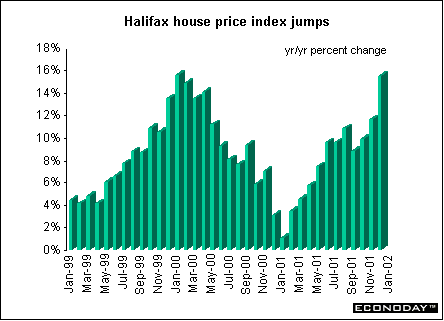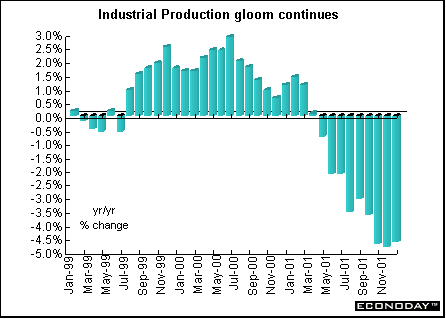
Indicator scoreboard
EMU - January seasonally adjusted Reuters purchasing managers service activity index rose to 51.0 from 49.2 in December. Input prices rose sharply with the introduction of euro cash, and companies began passing on a part of the extra costs to customers. An index reading above 50 signals that activity is expanding and a reading below 50 that it is contracting. The composite index, which combines the PMI's of the service and industrial sectors, rose to 49.7 from 47.6.
December seasonally adjusted unemployment rate remained unchanged at 8.5 percent. Of the ten EMU states reporting data, two posted a decline in unemployment, four a rise, and four no change. It is estimated that 11.7 million men and women were unemployed in the eurozone.

December industrial producer prices (excluding construction) fell 0.3 percent and were down 1.1 percent when compared with last year. The decline was paced by energy prices, down 1.1 percent, and by intermediate goods, down 0.2 percent on the month. Prices for capital goods, durable and non-durable consumer goods all rose by 0.1 percent.

Third quarter gross domestic product rose at an unrevised 0.1 percent and 1.4 percent when compared with last year.
EU - January economic sentiment index edged up slightly to 99.0 as the further recovery in industry confidence was largely offset by erosion in sentiment among consumers, retailers and builders. Industrial sentiment rose to minus 14 from minus 17 in December. Consumer sentiment slipped to minus 11 from minus 10 in December.

Germany - January seasonally adjusted unemployment jumped 31,000. West German unemployment rose by 28,000 and in the east it rose by 6,000. The unadjusted unemployment level - the figure headlined by German newspapers - rose to 4.29 million in January, above the psychologically important 4 million mark for the first time since February 2001. The unadjusted unemployment rate jumped to 10.4 percent from 9.6 percent in December. The seasonally adjusted unemployment rate rose to 9.6 percent from 9.5 percent, while the EU harmonized, seasonally adjusted rate of jobless rose to 8.1 percent from 8.0 percent.

December manufacturing orders jumped 5.0 percent thanks to an unusually large number of orders for big ticket items, particularly from abroad. Yet orders were still 4.7 percent below the level of a year earlier. Orders were up 4.7 percent in west Germany and 8.3 percent in east Germany. Domestic orders jumped 5.6 percent and foreign demand rose 4.5 percent.

December seasonally adjusted industrial production rose 1.9 percent but was down 3.3 percent when compared with last year. The increase was mainly due to an above average rise in the construction sector, which was up 3.2 percent. Excluding construction, industrial production rose 1.7 percent. The manufacturing sector, combining basic goods, capital goods and consumer goods, but excluding all energy goods and including non-energy mining, rose 1.6 percent. West German industrial output rose 1.9 percent after a drop of 1.5 percent in November, while in the east production rose 0.7 percent after a 1.1 percent drop in November.

Britain - January Halifax house price index rose 1.6 percent and 16.8 percent when compared with last year. Although this largely reflects a bounce back in consumer confidence from the lows of the September terrorist attacks, supply shortages in the market are also contributing to higher house prices.

December manufacturing output dropped 0.5 percent and 6.4 percent when compared with last year. The declines were widespread across nearly all manufacturing sub-sectors. Ten out 13 categories showed monthly declines, led by a 1.9 percent fall in the basic metals and metal products industry. The wider measure of industrial production fell 0.3 percent and was down 4.6 percent on the year. A 0.5 percent decline in utilities output was offset by 1.7 percent monthly gain in mining and quarrying output.

Americas
Canada - January employment rose by 76,000, the first major increase in more than a year. Part-time employment rose 46,000 and full-time employment rose 30,000. The unemployment rate fell 0.1 percent to 7.9 percent. Factory employment rose for only the third time in the last 13 months. Computer and electronic products, and transportation equipment manufacturing continued to decline while gains were made in paper production and printing.



Last Week's Highlights • Global
Stock Market Indexes • Recap of Global Markets
• Currencies • Indicator
Scoreboard

The Bottom Line •
Looking Ahead
|